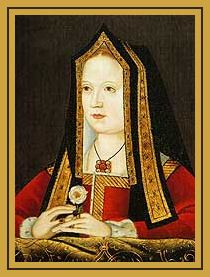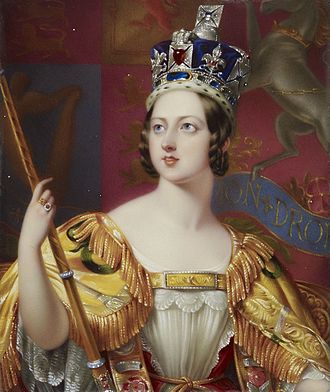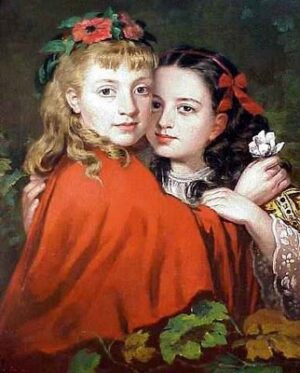
Early Life
Elizabeth of York was born at the Palace of Westminster as the eldest child of King Edward IV and his wife, Elizabeth Woodville.Her christening was celebrated at Westminster Abbey, sponsored by her grandmothers, Jacquetta of Luxembourg, Duchess of Bedford, and Cecily Neville, Duchess of York. Her third sponsor was her cousin Richard Neville, 16th Earl of Warwick.
In 1469, at the age of three, she was briefly betrothed to George Neville. His father John later supported George’s uncle, the Earl of Warwick, in rebellion against King Edward IV and the betrothal was called off.
In 1475, Louis XI agreed to the marriage of nine-year-old Elizabeth of York to his son Charles, the Dauphin of France. In 1482, however, Louis XI reneged on his promise.
Elizabeth was named a Lady of the Garter in 1477, along with her mother and her paternal aunt Elizabeth of York, Duchess of Suffolk.
Under the Reign of Edward V
On 9 April 1483, Elizabeth’s father, King Edward IV, unexpectedly died and her younger brother, Edward V, ascended to the throne. Her uncle, Richard, Duke of Gloucester, was appointed regent and protector of his nephews. Richard opted to take steps into isolating his nephews from their Woodville relations, including their own mother.
He intercepted Edward V while the latter was travelling from Ludlow, where he had been living as Prince of Wales, to London to be crowned king. Edward V was placed in the royal residence of the Tower of London, ostensibly for his protection.
Elizabeth Woodville fled with her younger son Richard and her daughters, taking sanctuary in Westminster Abbey. Gloucester asked Archbishop Bourchier to take young Richard with him, so that the boy could reside in the Tower and keep his brother Edward company. Elizabeth Woodville, under duress, eventually agreed.
Two months later, on 22 June 1483, Edward IV’s marriage was declared invalid. It was claimed that Edward IV had, at the time of his marriage to Elizabeth Woodville, already been betrothed to Lady Eleanor Butler.
Parliament issued a bill, Titulus Regius (“Royal Title”), in support of this position. This measure legally bastardised the children of Edward IV, making them ineligible for the succession and declared Gloucester the rightful king with the right of succession reverting to children of George, 1st Duke of Clarence, another late brother of Gloucester, who had been attainted in 1478.
Gloucester ascended to the throne as Richard III on 6 July 1483, and Edward and Richard disappeared soon afterwards. Rumours began to spread that they had been murdered and these appear to have been increasingly widely credited, even though some undoubtedly emanated from overseas.
Under the reign of Richard III
Elizabeth’s mother made an alliance with Lady Margaret Beaufort, mother of Henry Tudor, later King Henry VII, who had the closest claim to the throne among the Lancastrian party.
Although Henry Tudor was descended from King Edward III, his claim to the throne was weak, owing to an Act of Parliament of the reign of Richard II in the 1390s which barred accession to the throne to any heirs of the legitimised offspring of Henry’s great-great-grandparents, John of Gaunt and Katherine Swynford.
Whatever the merits of Henry’s claim, his mother and Elizabeth Woodville agreed he should move to claim the throne and, once he had taken it, marry Elizabeth of York to unite the two rival houses.
In December 1483, in the cathedral of Rennes, Henry Tudor swore an oath promising to marry her and began planning an invasion.
In 1484, Elizabeth of York and her sisters left Westminster Abbey and returned to court when Elizabeth Woodville was apparently reconciled with Richard III.
It was rumoured that Richard III intended to marry Elizabeth of York because his wife, Anne Neville, was dying and they had no surviving children. Soon after Anne Neville’s death, Richard III sent Elizabeth away from court to the castle of Sheriff Hutton and opened negotiations with King John II of Portugal to marry his sister, Joan, Princess of Portugal and have Elizabeth marry their cousin, the future King Manuel I of Portugal.
Henry Tudor and his army landed in Wales on 7 August 1485 and marched inland. On 22 August, Henry Tudor and Richard III fought the Battle of Bosworth Field.
Richard III had the larger army, but was betrayed by one of his most powerful retainers, William Stanley and died in battle. Henry Tudor took the crown by right of conquest as Henry VII.
Marriage to Henry VII
As the eldest daughter of Edward IV with no surviving brothers, Elizabeth of York had a strong claim to the throne in her own right, but she did not assume the throne as queen regnant.
Though initially slow to keep his promise, Henry VII acknowledged the necessity of marrying Elizabeth of York to ensure the stability of his rule and weaken the claims of other surviving members of the House of York.
It seems Henry wished to be seen as ruling in his own right, having claimed the throne by right of conquest and not by his marriage to the de facto heiress of the House of York as he had no intention of sharing power.
He consequently chose to be crowned on 30 October 1485, before his marriage.
Henry VII had the Act of Titulus Regius repealed, thereby legitimising anew the children of Edward IV and acknowledging Edward V as his predecessor. Though Richard III was regarded as a usurper, his reign was not ignored.
Henry and Elizabeth required a papal dispensation to wed because of Canon Law frowning upon ‘affinity” as both were descended from John of Gaunt or his older brother Lionel in the 4th degree, an issue that had caused much dispute and bloodshed as to which claim was superior.
Two applications were sent, the first more locally and the second one was slow in reaching Rome and slow to return with the response of the Pope. Ultimately, however, the marriage was approved by papal bull of Pope Innocent VIII dated March 1486 stating that the Pope and his advisors “approveth confirmyth and stablishyth the matrimonye and coniuncion made betwene our sou[er]ayn lord King Henre the seuenth of the house of Lancastre of that one party And the noble Princesse Elyzabeth of the house of Yorke.
Because the journey to Rome and back took many months, and because Henry as king wanted to be certain that nobody could claim that his wedding to Elizabeth was unlawful or sinful, the more local application was obeyed first – it was sent to the papal legate for England and Scotland, which returned in January 1486.
Cardinal Bourchier, Archbishop of Canterbury, officiated at the wedding of Henry VII and Elizabeth of York on 18 January 1486 in Westminster Abbey.
Their first son, Arthur, was born on 20 September 1486, eight months after their marriage. Elizabeth of York was crowned queen on 25 November 1487. She gave birth to several more children, but only four survived infancy: Arthur, Margaret, Henry and Mary.
Despite being a political arrangement at first, the marriage proved successful and both partners appear to have slowly fallen in love with each other.
Thomas Penn, in his biography of Henry VII writes that “though founded on pragmatism, Henry and Elizabeth’s marriage had nevertheless blossomed throughout the uncertainty and upheaval of the previous eighteen years. This was a marriage of ‘faithful love’, of mutual attraction, affection and respect, from which the king seems to have drawn great strength.”
Death
In 1502, Elizabeth of York became pregnant once more and spent her confinement period in the Tower of London. On 2 February 1503, she gave birth to a daughter, Katherine, but the child died a few days afterwards.
Succumbing to a post partum infection, Elizabeth of York died on 11 February, her 37th birthday. Her family seems to have been devastated by her death and mourned her deeply.
According to one biographer, the death of Elizabeth “broke the heart” of her husband and “shattered him.” Another account says that Henry Tudor “privily departed to a solitary place and would no man should resort unto him.”
This is notable considering that, shortly after Elizabeth’s death, records show he became deathly ill himself and would not allow any except his mother Margaret Beaufort near him, including doctors.
For Henry Tudor to show his emotions, let alone any sign of infirmity, was highly unusual and alarming to members of his court.


